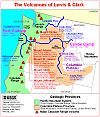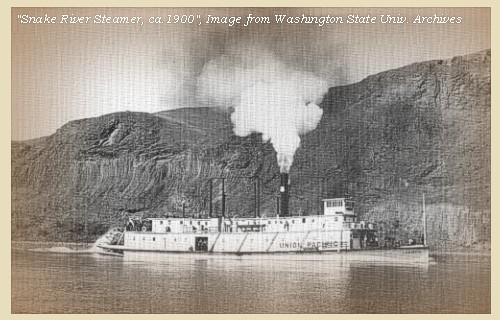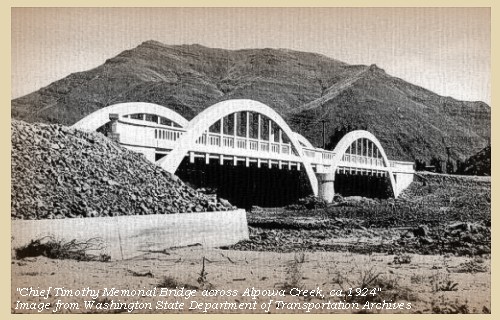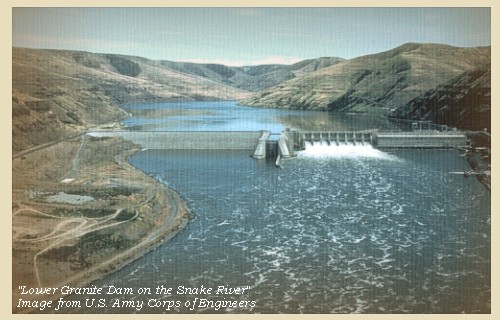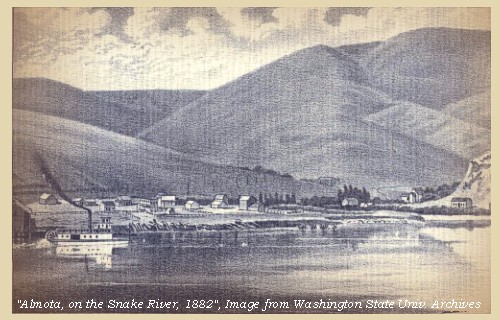The Volcanoes of
Lewis and Clark
Lewis and Clark
|
October 11, 1805 On the Snake River - Clearwater Confluence to Almota Creek |
|
Home
The Volcanoes of Lewis and Clark Map of the Journey Volcanoes, Basalt Plateaus, Major Rivers, etc. The Volcanoes Mount Adams, Mount Hood, Mount Jefferson, Mount Rainier, and Mount St. Helens CALENDAR of the Journey October 1805 to June 1806 Along the Journey Pacific Northwest Maps - Columbia River, Volcanoes, Flood Basalts, Missoula Floods, Geology, etc. The Corps of Discovery The Journey of Lewis and Clark About the Reference Materials The Journals, Biddle/Allen, DeVoto, Gass, Moulton, Topo Maps, and others USGS Lewis and Clark Links Links to USGS Websites highlighting the Lewis and Clark Journey Resources Publications Referenced and Websites Visited |
PREVIOUS
October 10 Reaching the Snake, Clearwater Confluence with the Snake River |
October 11
On the Snake River, Clearwater Confluence to Almota Creek Snake River, Washington State Geology, Alpowa Creek, Chief Timothy State Park, Lower Granite Dam and Lower Granite Lake, Almota Creek and Almota (Washington) |
CONTINUE
October 12 On the Snake River, Almota Creek to Texas Rapids |
|
To the Pacific - October 1805
On the Snake - Clearwater Confluence to Almota Creek |
| Lewis and Clark's camp of October 10, 1805, was on the north bank, at the confluence of the Snake River with the Clearwater River, the site of today's Lewiston, Idaho, and Clarkston, Washington. On October 11, 1805, the men begin their trip down the Snake River. |
| Friday, October 11, 1805 |
| This morning the wind was from the east, and the weather cloudy. We set out early, [The beginning of their journey down the Snake River] and at the distance of a mile and a half reached a point of rocks in a bend of the river towards the left, near to which was an old Indian house, and a meadow on the opposite bank. |
| Lewis and Clark have not only begun their journey down the Snake River, but have also begun their journey in land which, in 1889, would become Washington State. |
|
|
|
Washington State Geology:
Washington State's geology is highly diverse. Rocks of Precambrian age, as well as units from every geologic period, Cambrian to Quaternary, are represented. The state has been subject to continental collisions, metamorphism, intrusion of igneous rocks, volcanism, mountain-building episodes, erosion, glaciation, and massive flooding events. -- Norman and Roloff, 2004, Washington DNR Open-File Report 2004-7 |
| Here the hills came down towards the water, and formed by the rocks, which have fallen from their sides, a rapid over which we dragged the canoes. We passed, a mile and a half further, two Indian lodges in a bend towards the right, and at six miles from our camp of last evening reached the mouth of a brook on the left [Alpowa Creek, today the location of Chief Timothy State Park]. Just above this stream we stopped for breakfast. ...... |
| On leaving this encampment [Alpowa Creek] we passed two more rapids, and some swift water, and at the distance of four and a half miles reached one which was much more difficult to pass. Three miles beyond this rapid, are three huts of Indians on the right, where we stopped and obtained in exchange for a few trifles some pashequa roots, five dogs and a small quantity of dried fish. We made our dinner of part of each of these articles, and then proceeded on without any obstruction, till after making twelve and a half miles we came to a stony island on the right side of the river, opposite to which is a rapid, and a second at its lower point. |
| The Lower Granite Lock and Dam is now located along this section of the Snake River, at River Mile 107.5. Lower Granite Lake is the reservoir extending nearly 40 miles behind the dam. |
| About three and a half miles beyond the island is a small brook which empties itself into a bend on the right [Almota Creek], |
| where we encamped at two Indian huts, which are now inhabited. [just below Lower Granite Dam] ...... The country on both sides, after mounting a steep ascent of about two hundred feet, becomes an open, level and fertile plain, which is, however, as well as the borders of the river itself, perfectly destitute of any kind of timber; and the chief growth which we observed consisted of a few low blackberries. We killed some geese and ducks. The wind in the after part of the day changed to the southwest and became high. |
| "... The country on both sides is high dry prairie plains without a stick of timber. There is no wood of any kind to be seen except a few small willows along the shore; so that it is with difficulty we can get enough to cook with. The hills on the river are not very high, but rocky; the rocks of a dark colour. The bed and shores of the river are very stony; and the stones of a round smooth kind ..." [Gass, October 11, 1805] |
|
|
|
The Camp - October 11, 1805:
Lewis and Clark's camp of October 11, 1805, was located on the Snake River near the mouth of Almota Creek, approximately 4 miles downstream of the Lower Granite Dam. |
| Home | Previous | Continue |
If you have questions or comments please contact: GS-CVO-WEB@usgs.gov
June/July 2004, Lyn Topinka
The Volcanoes of Lewis and Clark Home Page | CVO Home Page

